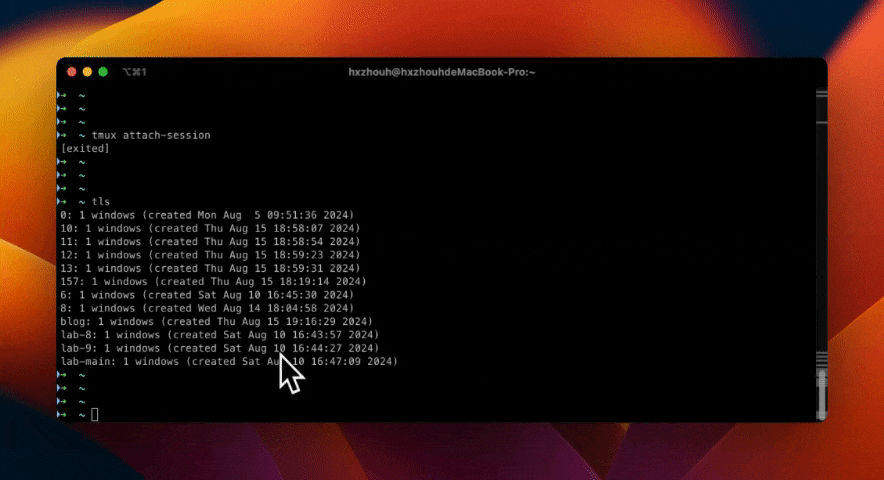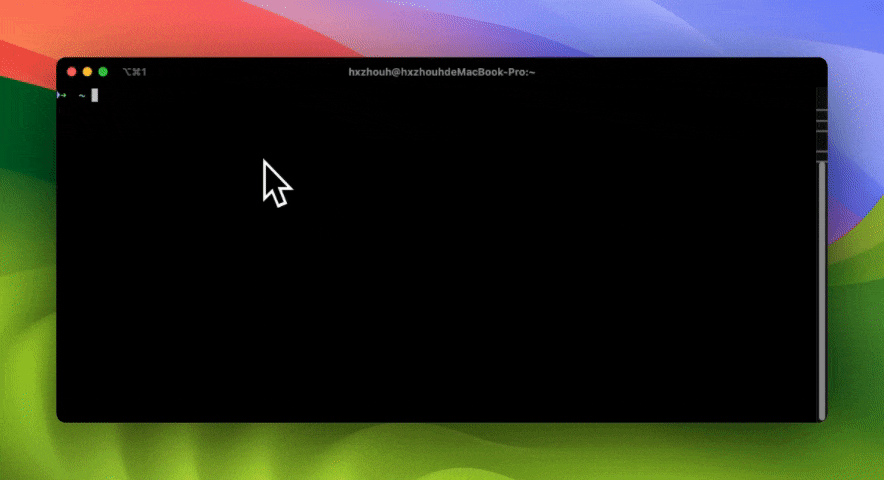tmuxis a terminal multiplexer: it enables a number of terminals to be created, accessed, and controlled from a single screen.tmuxmay be detached from a screen and continue running in the background, then later reattached.
My first encounter with tmux left me unimpressed—I didn’t see the appeal. However, as I spent more time working with the terminal and faced various challenges, I revisited tmux and was amazed at how it revolutionized my workflow. This article aims to give a ten-minute introduction to the basics of tmux and its practical applications.
Understanding Terminal Sessions
Reflect on how you typically use the terminal in your daily work. You open an iTerm2 window, use SSH to connect to a remote machine, navigate to a specific directory, and start working. Once done, you close the iTerm2 window. This entire process is a terminal session. Its lifecycle is tied to the terminal’s lifecycle, meaning the session ends when you close the window. How can you decouple the session from the terminal, eliminating the need to repeat these steps each time? This is where tmux comes in handy.
Let’s explore how to use tmux to achieve this functionality.

In this demonstration, I create a tmux session using tmux new -s test, log into my development machine, detach the session, return to the iTerm2 terminal, and then use tmux attach-session to reconnect to the same development machine session exactly as I left it. This is the basic application of tmux: detaching and maintaining session states.
TL;DR
tmux enables us to:
- Access multiple sessions within a single window, useful for running several command-line programs simultaneously.
- Attach new windows to existing sessions.
- Allow multiple connected windows for each session, enabling real-time session sharing among multiple users.
- Support arbitrary vertical and horizontal window splitting.
Basic Usage of tmux
Installing tmux
On Mac, you can install tmux using brew:
|
|
For other environments, refer to Installing tmux.
Starting and Exiting tmux
Once installed, type tmux in the terminal to start a tmux session. To exit the tmux session and return to the original terminal screen, simply enter exit.

Prefix Key
Unlike other software, all shortcuts in tmux are combined with the prefix key ⌃b (where ⌃ is the control key on Mac). This reduces conflicts with other software. You can view all shortcuts by pressing ⌃b+?. tmux shortcuts generally fall into three categories: window, pane, and session management.
Session Management
Running the tmux command multiple times will open multiple tmux sessions. Within a tmux session, you can manage sessions using the prefix key ⌃b along with the following shortcuts:
⌃b + $— Rename the current session⌃b + s— Choose from a list of sessions⌃b + d— Detach the current session, returning to the terminal’s main screen.
In the terminal, sessions can be managed with the following commands:
tmux new -s foo— Create a new session namedfootmux ls— List alltmuxsessionstmux a— Attach to the last sessiontmux a -t foo— Attach to a session namedfoo; sessions are named numerically by defaulttmux kill-session -t foo— Delete the session namedfootmux kill-server— Delete all sessions
Using aliases can enhance your experience. For example, here are my custom configurations:
|
|
Pane Management
tmux can split windows into multiple panes, with each pane running a different command. These commands are executed within the tmux window.
⌃b + %— Split the pane horizontally⌃b + "— Split the pane vertically⌃b + x— Close the current pane⌃b + {— Move the current pane to the left⌃b + }— Move the current pane to the right⌃b + ;— Switch to the last used pane⌃b + o— Switch to the next pane (you can also use arrow keys)⌃b + space— Cycle through pane layouts;tmuxhas five built-in layouts, switchable via⌥1to⌥5⌃b + z— Maximize the current pane; repeat to restore to original size⌃b + q— Display pane numbers; press the corresponding number to switch to that pane
Window Management
tmux also supports the concept of windows. When panes become crowded, you can open a new window. Here are some commonly used shortcuts for managing windows:
⌃b + c— Create a new window; this will switch to the new window without affecting the state of the existing window⌃b + p— Switch to the previous window⌃b + n— Switch to the next window⌃b + w— Choose from a list of windows; use⌃pand⌃nto navigate on macOS⌃b + &— Close the current window⌃b + ,— Rename the window; supports Chinese characters for easy identification in thetmuxstatus bar⌃b + 0— Switch to window 0; use other numbers to switch to corresponding windows⌃b + f— Search and select windows by name; supports fuzzy matching
Conclusion
This article provides a basic summary of how to use tmux and its shortcuts. Many more advanced use cases exist, such as integrating with vim for more efficient coding. I hope this overview encourages you to try tmux and enhance your productivity with this powerful tool.